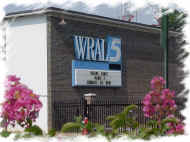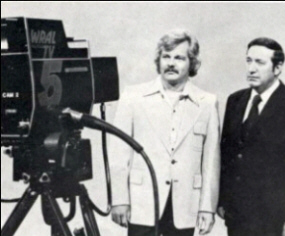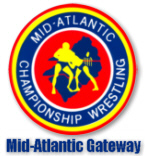
|
|
|
|
Conversations with Les Thatcher: Local Promo Tapings at WRAL |
|
|
From 1974-1977, Les Thatcher did the local promos that were inserted into each Mid-Atlantic show for each local market. The shows were taped at WRAL TV studios in Raleigh, NC. We talked with Les about how and when those promos were done, offering interesting insight to the making of Mid-Atlantic Championship Wrestling on television. |
|
|
Dick Bourne: The tapings in Raleigh were on a Wednesday night, I remember. Did you do the local spot promos before the tapings? Les Thatcher: Yes. What we did, we usually started about noon, and we used to average over a hundred spots a Wednesday afternoon.
LT: That show was in 30-some markets and we had two 2:20 spots per show, plus some of the 30 second promos we cut to go into some of those markets, too. And then occasionally some of the boys might be booked out to Eddie Graham or down to Atlanta, so we’d cut promos to ship out to them. Of course, as antiquated as it all sounds now, back then it worked. I would go into the (Charlotte) office on Monday and George Scott would give me the line-ups, start times, buildings, towns, and so forth. I had an office in the (wrestling) office, but I also had an office at home, they didn’t much care where I worked as long as I got the stuff done. But I would take that old yellow newsroom-type paper, perforated paper that would fold; Jimmy (Crockett) bought that for me by the box. It would fold easy, and I would take a grease pencil and I would write, for example, Friday Night, June the 6th, Richmond, Virginia, the Coliseum, bell time, whatever, and then I would list a few stars, and then one or two matches and the stipulations. And we often would plug three towns off of the same TV. Those were my cues. Nothing was written out for me, there were no teleprompters, no cue cards. DB: I always wondered if someone was holding cue cards. LT: Well, Danny Miller helped out with it. Gene Anderson was working in the office at the time, he helped out with it. George Scott himself would help. What they did was take my folded stack of paper and tape them to the top of a music stand, because the post on the music stand was adjustable, and they would make it just high enough that it would fit right under the camera lens. So let’s say, Flair and I are finishing up the last 2:20 on the Richmond tape, and I’ve got that music stand with the Richmond info sitting in front of me; Ric’s on my left, and he’s doing his pitch. And we had a back timer, like photographers use, and that’s how we kept our time. And that was on a stand sitting right there, too. So anyway, we’d wrap up that 2:20 for Richmond, he would step off to the left, Gene or George or Danny or whoever would change the music stand, and now we’ve got the first 2:20 for Raleigh, for example. And then here comes Blackjack in on my right. And we’d hit that 2:20, and then for the same show we’d do the 2:20 (with Blackjack’s opponent) in on the other side . . . DB: So you would do each city’s promos back to back, babyfaces and then heels? LT: Yes, and I got off of that set for two reasons and two reasons only: to go to the bathroom or to grab a quick bite to eat. That was probably the first place I worked where they catered anything in because we were there so long. Now days, it’s standard procedure in both TV companies to have food catered in. But back then, they’d bring in Col. Sanders for us. And also, as well as I was dressed (for the TV), I finally succumbed to crape-soled work shoes because I was standing on that concrete so much. DB: And your shoes never showed on TV . . . LT: Exactly. So once I was aware of that, I said, hell I’m driving myself crazy wearing these shoes. We would start at noon and sometimes it was 5 o’clock before we were finished. DB: I don’t see how your voice held out. LT: I’m not sure, either, to tell you the truth, Dick. And the funny thing is, I got that 2:20 in my head, you’re doing a hundred of these every Wednesday, and then I go to Knoxville and do my spots up there (for Southeastern Championship Wrestling) . . . DB: What day did you do those for Knoxville? LT: We did TV up there on Saturday mornings. But there were times that someone would step on the plug of that back timer, or for whatever reason it would stop, I would keep the interview going, and I swear to you, I could finish it within a couple of seconds one way or the other of the exact time, because I had done them so many times. DB: I guess you just get in a rhythm.
LT: Yes, exactly. My schedule, when I was doing both shows between November of 1974 and February or March of 1978, before I moved to Knoxville, I would, as I said, go in (to the Charlotte office) and get the stuff from George on Monday, was helping with the magazine, and the TV in Charlotte, plus I was wrestling a couple of nights a week, and then we’d go to a show on Tuesday, and then drive up from Charlotte early that Wednesday morning, did promos from noon to 5 o’clock, grabbed a bite to eat, I was hosting the one show, Caudle was hosting the other. And then once I started doing the Knoxville show, I think Jimmy was afraid people would see Les on two shows in the same market, and that’s basically when Ed Capral came in. DB: That must have been in 1975 or 1976, because when I first discovered Wide World Wrestling on channel 13 in Asheville, Ed Capral was the host. I never knew you hosted one of the shows until I read it on your site. LT: Yep, I sure did. You mention channel 13 in Asheville; do you know in that three-station market what our share or percentage of homes tuned in to that show was? DB: I remember knowing that it was huge . . . LT: Between 70-80%. DB: Good grief! LT: Yep, when our show was on the air in that three station market, our show was watched by between 70 and 80 percent of the homes available to those three stations. DB: Unbelievable. LT: Another guy in the Crockett office, who wasn’t involved in the wrestling, we put together a promotional packet, laid out the design for the little cover and all that, and in there we had a sampling of the different markets we were in and what kind of shares and numbers we pulled there. That’s how I remember the Asheville thing so vividly. So when people think wrestling’s popularity started with Hulk Hogan, it just drives me crazy. But anyway, we’d do the TV in Raleigh on Wednesday, and then Thursday, I’d wrestle for Crockett someplace, then Friday morning, I would get on Piedmont Airlines, remember them? DB: I certainly do. LT: I would get on a Piedmont flight in Charlotte that hopped into Greenville/Spartanburg, then into Asheville, and it finally got me to Knoxville. Ron (Fuller) would pick me up at the airport, we’d do lunch, go to his house, we’d lay out the TV, I helped him with the booking along with Nelson Royal, then we’d work Knoxville Friday night, and then do TV Saturday morning, work a house show some place Saturday night and I’d get back on the bird Sunday morning, and I’d do it all over again. * * * * * Also see: Studio Wrestling: WRAL in Raleigh | Wednesdays in the Video Tape Room at WRAL
|
|

 DB: I can believe it, given the number of markets.
DB: I can believe it, given the number of markets.
